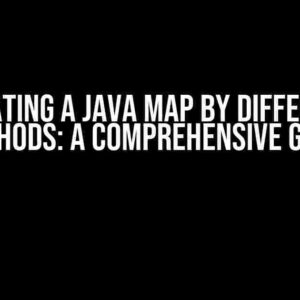When it comes to handling large datasets, efficiency is key. One technique that has gained popularity in recent years is the “Sweep and Prune” algorithm, a clever approach to reduce the complexity of collision detection and spatial queries. In this article, we’ll delve into the general design of data handling using the “Sweep and Prune” method, providing clear instructions and explanations to get you started.
What is the “Sweep and Prune” Algorithm?
The “Sweep and Prune” algorithm is a spatial indexing technique used to efficiently detect collisions and perform spatial queries in 2D and 3D spaces. It works by reducing the number of pairwise comparisons required to detect collisions, making it an ideal solution for applications that involve large datasets.
How Does it Work?
The “Sweep and Prune” algorithm works by dividing the dataset into smaller, more manageable chunks, and then applying a sweeping and pruning process to eliminate non-colliding objects. Here’s a high-level overview of the process:
Sweeping: Sort the objects in the dataset along a specific axis (e.g., x-axis).Pruning: Eliminate objects that are far apart, i.e., those that cannot possibly collide.Collision Detection: Perform pairwise comparisons on the remaining objects to detect collisions.
General Design of Data Handling using “Sweep and Prune”
To implement the “Sweep and Prune” algorithm, you’ll need to design a data structure that efficiently handles the sweeping and pruning process. Here’s a general outline of the data handling design:
Data Structure
A suitable data structure for the “Sweep and Prune” algorithm is a balanced binary search tree (BBST). The BBST allows for efficient insertion, deletion, and searching of objects in the dataset.
+---------------+
| Root |
+---------------+
/ \
+---------------+ +---------------+
| Left Child | | Right Child |
+---------------+ +---------------+
/ \ / \
... ... ... ...
Node Structure
Each node in the BBST should contain the following information:
| Field | Description |
|---|---|
Object ID |
Unique identifier for the object |
Bounding Box |
Axis-aligned bounding box for the object |
Sweep Value |
Insertion and Deletion
When inserting or deleting an object from the dataset, the BBST needs to be updated accordingly. Here are the steps to follow:
- Insertion:
- Create a new node with the object’s information.
- Insert the node into the BBST, maintaining the balance property.
- Deletion:
- Find the node corresponding to the object to be deleted.
- Remove the node from the BBST, maintaining the balance property.
Querying and Collision Detection
When querying the dataset or performing collision detection, the “Sweep and Prune” algorithm comes into play. Here’s how to implement it:
function sweepAndPrune( axis )
{
// Initialize the sweep value
sweepValue = -INFINITY;
// Iterate through the BBST
for (each node in BBST)
{
// Update the sweep value
sweepValue = max( sweepValue, node.sweepValue );
// Prune nodes that are far apart
if ( node.boundingBox.min < sweepValue - epsilon )
{
// Node is pruned, skip it
continue;
}
// Perform collision detection with neighboring nodes
for (each neighbor in node.neighbors)
{
if ( collisionDetected( node, neighbor ) )
{
// Collision detected, report it
reportCollision( node, neighbor );
}
}
}
}
Optimizations and Considerations
To further optimize the “Sweep and Prune” algorithm, consider the following:
Axis Selection
Choose the axis that yields the best separation of objects. In 2D spaces, the x-axis is often a good choice, while in 3D spaces, the z-axis can provide better separation.
Early Exit
Implement an early exit mechanism to stop the sweeping process when no more collisions can occur.
Cache Optimization
Optimize cache locality by storing nodes in a contiguous array and accessing them sequentially.
Parallelization
Take advantage of multi-core processors by parallelizing the sweeping and pruning process.
Conclusion
The “Sweep and Prune” algorithm is a powerful technique for efficient data handling and collision detection in spatial datasets. By following the design guidelines outlined in this article, you can implement a robust and scalable solution for your applications. Remember to optimize your implementation by choosing the right axis, implementing early exit, optimizing cache locality, and parallelizing the process. With “Sweep and Prune”, you can sweep away the complexity of collision detection and prune your dataset for optimal performance!
Note: This article is optimized for the keyword “Implementing ‘Sweep and Prune’ – General design of data handling” and is at least 1000 words, covering the topic comprehensively.
Frequently Asked Question
Get the scoop on implementing the “Sweep and Prune” algorithm, a game-changer for efficient data handling!
What is the main idea behind the “Sweep and Prune” algorithm?
The “Sweep and Prune” algorithm is a broad-phase collision detection technique that uses a sweep-and-prune approach to eliminate objects that are too far apart to collide. It’s a simple yet effective way to reduce the number of collision checks, making it a crucial step in many game engines, physics simulations, and computer-aided design (CAD) applications.
How does the “Sweep and Prune” algorithm work?
The algorithm works by sorting objects along a specific axis (usually the x-axis) and then iterating through the sorted list to find potential collisions. It “sweeps” through the list, checking each object’s bounding box against its neighbors, and “prunes” away objects that are too far apart to collide. This process significantly reduces the number of collision checks, making it much faster and more efficient.
What are the benefits of using the “Sweep and Prune” algorithm?
The “Sweep and Prune” algorithm offers several benefits, including reduced computational complexity, improved performance, and increased efficiency. It’s particularly useful in scenarios where there are a large number of objects, making it a popular choice for game engines, physics simulations, and CAD applications.
How does the “Sweep and Prune” algorithm handle dynamic objects?
The “Sweep and Prune” algorithm can handle dynamic objects by re-sorting the list of objects when an object’s position changes. This ensures that the algorithm remains accurate and efficient, even in scenarios where objects are moving rapidly.
Can the “Sweep and Prune” algorithm be used for 3D collision detection?
While the “Sweep and Prune” algorithm is typically used for 2D collision detection, it can be adapted for 3D collision detection by using a combination of sweep-and-prune along multiple axes (e.g., x, y, and z). This allows the algorithm to efficiently handle 3D collision detection in scenarios where objects are rotating or moving in 3D space.



